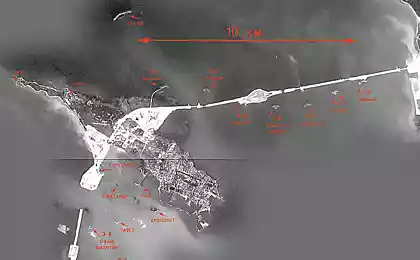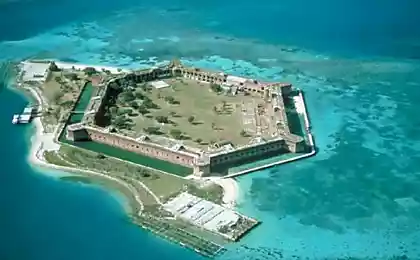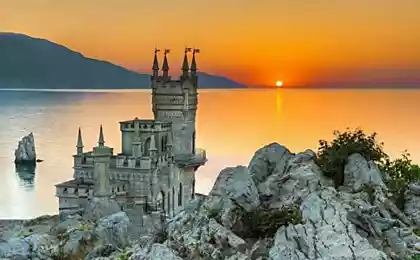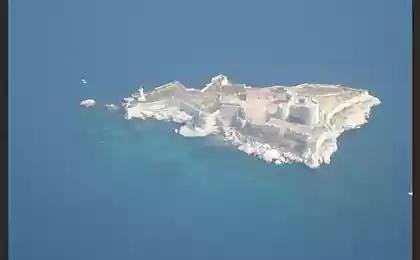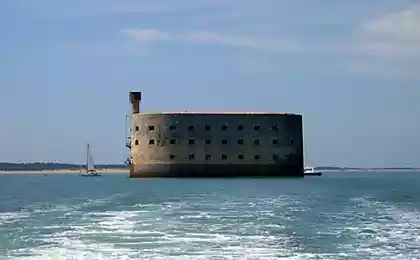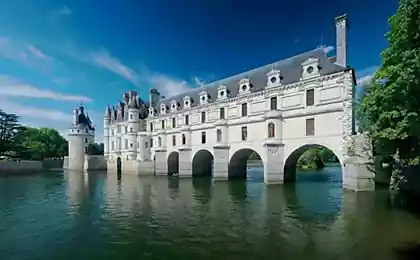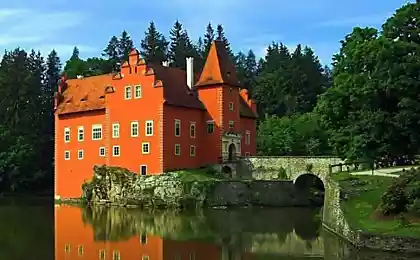2402
History of the Chateau d'If (36 pics + 2 video)
"Dantes stood up, I looked in the direction where to direct the boat, and
I saw about a hundred yards in front of him a black sheer cliff,
on which stood a dark castle d'If.
This quaint look of this prison, which causes a unprecedent-
worthwhile horror, this fortress, which has three hundred years its powers Marseille
creepy tales, suddenly emerged in front of Dantes, and did not think
about her made him the same effect, which produces a scaffold on
sentenced to death. »
Alexandre Dumas' The Count of Monte Cristo »

We all grew up on the books of Alexandre Dumas. One of his most successful and memorable works was the novel about a prisoner of the Chateau d'If "The Count of Monte Cristo." This famous novel was written during the years 1844-1845. To work turned plausible, the author personally bed all those places in which his characters were traveling.
So, France Corsica, Paris, Marseille, and finally, the Chateau d'If. That is why the book is so believable. In the former Soviet Union also withdrew their adaptation adventure Count of Monte Cristo, which still has not lost its relevance. Dark castle, in which the protagonist languished for many years, actually exists. Inspired by a real Chateau d'If, Alexandre Dumas created a terrible, tragic story about an incredibly strong man imagines himself equal to God and considers himself a hand of Providence. It is often the case that, if the characters are written out by this master, they seem quite real fans.
No wonder England on Baker Street, there is a house-museum of Sherlock Holmes, who never existed, but whose address still get letters addressed to the brilliant detective. So many fans Count of Monte Cristo at the eyes to see the Chateau d'If and the camera, which allegedly languished Edmond Dantes. Therefore, the lock, even architecturally inferior to many castles of France, thanks to the immortal genius of Alexandre Dumas, became a symbol of the will to live Edmond Dantes, once vowed to avenge his enemies.

Chateau d'If (fr. Shâteau d`If) located in the south of France in the department of Bush du Rhône (Bouches-du-Rhone) on the smallest island in the archipelago of Friuli (L`Archipel du Frioul), that are located within a mile of the coast of Marseille . Chateau d'If was built in 1527-1531 gg. on the orders of François I to protect the city against attacks from the sea. The castle has never been attacked and survived to our time in perfect condition. Today, Chateau d'If - one of the "business card" of Marseille. Many visitors tend to visit the castle. Castle guided tours on the camera, sold souvenirs, and in the open air is a cafe with a view of Marseille.
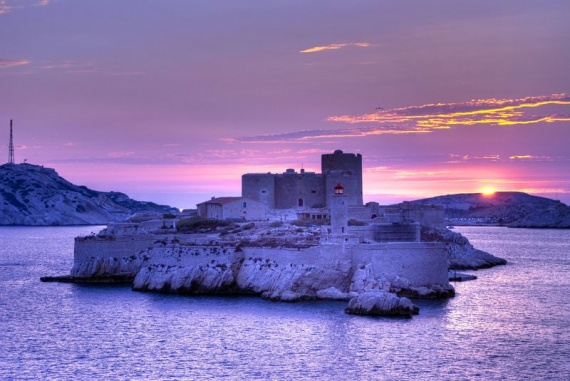
From what began the history of the island, which was later built the castle of If? Caesar mentioned the island, when he found himself near Marseille and settled on this small island for a few days before the battle.
Ifs Island archipelago of Friuli, adjacent to the islands and Pomeg Raton, is surprisingly close to Marseille, and is well seen, especially with the Corniche. Small, neat and high. At its widest point the island reaches 180 m., And its maximum length - 300 m. For a long time the island served as a refuge for pirates, smugglers, fishermen and hunters. Actually exists to the present day Chateau d'If was built in 1527-1531 gg. to protect the coast of Marseilles from enemy attack from the sea. Funny, that never in the Chateau d'If was not committed any attacks that made him to have survived in excellent condition and is a great temptation for tourists as fans of Dumas, who want the hard way to try to imagine the pain and suffering invented Edmond Dantes and those who simply love the well-preserved castles. The French title of the Chateau d'If Shâteau d`If. It is located in the Mediterranean Sea on the southern side of France in one of the small islands of the archipelago Friuli (L`Archipel du Frioul), in the department of Bush-du-Rhone. This protective structure protecting the sea lanes leading to Marseilles, its area is 30 thousand square meters.
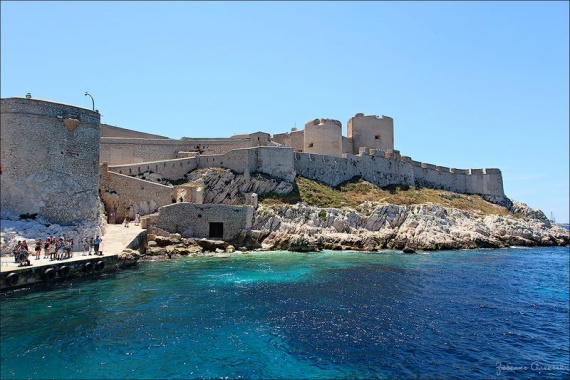
The castle itself is located within a mile of the coast of Marseille. The castle seems grown into the rock, as it was built and it is in the rock, towering over the island is only the external structure of the square shape with three round towers and a small patio. The outer walls merge with rocks. Also in the castle is a lighthouse. Ramparts of the castle towering over the island, they can be seen far from the sea and the coast. At the end of the XVI century on the perimeter of the island was built a fortress wall, observation tower and the church. In Marseille, Chateau d'If is very popular, there just bursting with tourists, the castle - former defensive bastion never empty. In spite of its defensive function, according to the engineer Vauban, Chateau d'If was built very badly, in a hurry, with a lot of flaws and punctures. So maybe the Chateau d'If lucky, he has never he did not have a direct role to carry out their protection from attack. Though, perhaps, many of the enemies of France, Marseille is not attacked because of the fearsome If Castle, who knows?
Only in the 1531 Spanish King Charles V decided to attack Marseilles, but for some reason changed his mind. The French believe that the king was frightened Chateau d'If. Perhaps the way it really was. What about the second role of the Chateau d'If, as so poetically described by Dumas and gloomy, the Chateau d'If indeed served as a prison for the politically unreliable Huguenots and other exiles who were not satisfied with the then political leadership of France.

Around 3500 and more prisoners were imprisoned in the Chateau d'If, why the protective structure has not got the best, rather grim reputation. The Chateau d'If in addition to personalities representing political danger for the French policy at the time, were also imprisoned leaders of the Paris Commune. Many Protestants, who were in the Chateau d'If from 1689, and there ended his life. From celebrities to the Chateau d'If languished young Mirabeau, who spent six months in prison, planted with his own father. But his camera was a luxury he could even hold in their methods. Despite the legend got accustomed, even one of the characters of Dumas - the mysterious Iron Mask - was imprisoned in the castle, as the Marquis de Sade, who was in many places, but not on this island.
But the camera sinister If Castle dissolute remember the hermit, which eventually burned at the stake, the captain of the ship "Grand St. Anthony", who was responsible for spreading the plague to Marseille and many other accidents have become captives of the stone walls of the world famous prison. In 1830 in the Chateau d'If criminals have stopped planting, but in 1871, here exiled leaders of the Paris Commune, and Gaston Cremieux, their leader, was shot in the territory of the Chateau d'If. The only time the gun fired on the island of Chateau d'If it happened when King Francis I met Catherine de Medici.
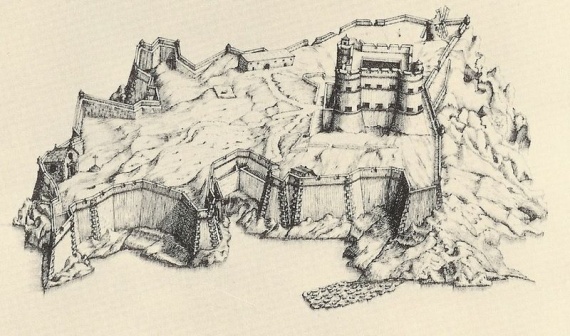
The military garrison on the island was served by a man of sixty.
The very first inmates of the castle was a knight Anselm, who was killed in his cell. Then, there is contained a lot of convicts, and even a sailor who rudely told his captain sat in his cell for 30 years.
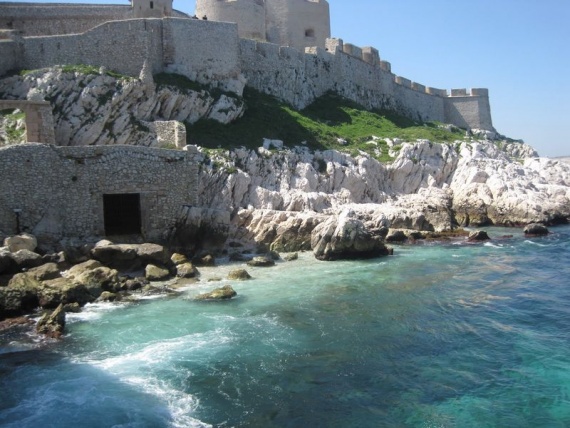
In what conditions contained prisoners? The rich, who could and from prison to manage their condition, settled in the upper chamber, where there was a window and "view of the sea." And the poorest thrown into the interior of the castle close to the camera without a single window.
For tourists, the castle was opened in 1890, and the demilitarized at the end of the 19th century. July 7, 1926 Chateau d'If a special decree was entered in the list of historic monuments of great national importance for France. To swim to the Chateau d'If is required to overcome the old pier and ancient fortifications made of stone. Steep road to the ancient walls leading to the castle itself, which is also a former Marseille plague quarantine. To climb to the castle, to climb the spiral staircase and exit the stuffy narrow courtyard, where there is a well, terrace with casemates, separated from each other by a rusty lattice. Each dungeon is marked commemorative plaque.
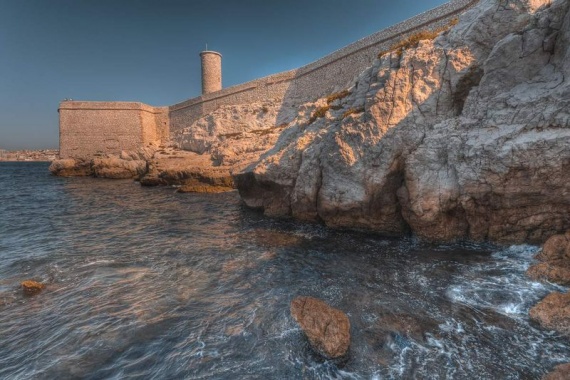
Narrow window detention cells If Castle casemate above each affixed memorial plaque: "Lock-man, nicknamed" the Iron Mask, "" The Comte de Mirabeau had spent the years 1774-1775 ", and finally" punishment cell E. Dantes, the Count of Monte Cristo. "

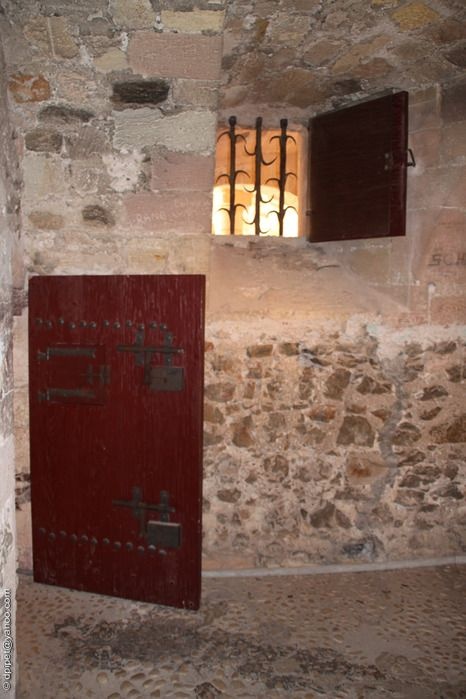
And it is "the same hole" through which Edmond Dantes climbed to the Abbe Faria.

For those who are really keen on creativity Dumas and his mysterious character Count of Monte Cristo, of course, is not difficult to guess that a real camera, which languished Edmond Dantes in the Chateau d'If, of course not. Although, as tourists in England show house of Sherlock Holmes, and tourists craving to admire the camera Edmond, show one of the cameras. Of course, this is not the dark chamber in the cave, which was mentioned in the novel, and the usual camera for state criminals.

In these cells kept as described by Alexander Dumas, is the state of criminals in the 19th century, when the Chateau d'If served as a prison. Until the 19th century, is erected in 1524 on the orders of François I, the castle was a protective garrison and as a place of incarceration of criminals unused. Now, this popular tourist castle receives many visitors from all over the world, then sell souvenirs, show the cell where prisoners were held as well as on the grounds of the castle there is a great cafe with a view of Marseille.
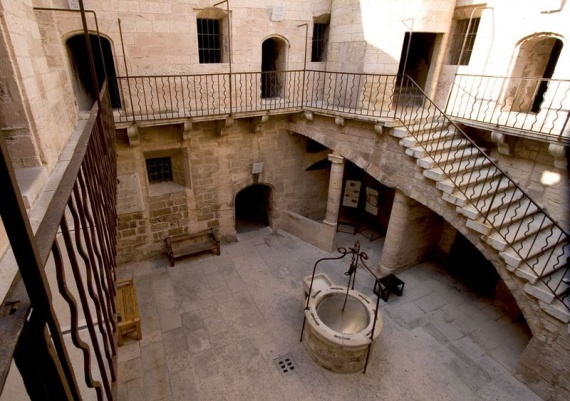
No less striking character of the famous works of Alexandre Dumas' The Count of Monte Cristo "is the Abbe Faria, who was the famous writer" settled "in the next cell Edmond Dantes in the Chateau d'If. It is this true scientist Edmond became a mentor in the Chateau d'If, and helped him to come to the image of a perfect being. There Is Abbe Faria really? Or it is the same way the fruit of the author of fiction, as does the Count of Monte - Cristo?

Dungeon Comte de Mirabeau, one of the most famous orators of the French Revolution.
Yes, Abbe Faria - a real historical person. In fact, the Abbe Faria owned hypnosis techniques, which he learned in India, where he was born. As in the novel, the Abbe Faria had dreamed about the independence of his people, he was able to speak beautifully and drag the human mass. And in real life Faria was in the role of perpetrator for their bold ideas about the freedom of his people. As a very dangerous criminal, shackled in chains, he was sent to Lisbon, and three years later the unknown patron helped courageous scientist flee to France. His book about hypnosis and hypnotic sessions in France were a great success, but for conspiring against the government of the abbot again crammed in solitary confinement in the Bastille. Again, a daring escape that failed bookish character of Dumas. And the Abbe Faria involved in the storming of the Bastille. And yet, like the book character Dumas, the real Abbe Faria died in prison in 1819, but not in the Chateau d'If.
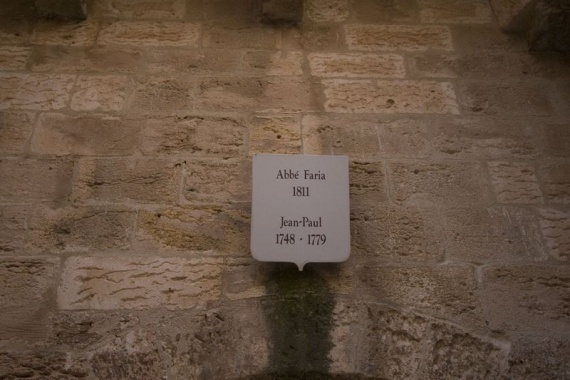
Camera Abbe Faria.

The heroes of Alexandre Dumas will live in our memories and our hearts, no matter what they never existed. It is quite banal protective structure made carelessly and in haste, Chateau d'If on the tiny island, will attract a new generation of tourists who, walking along Marcel will look hut bride Edmond, Mercedes, and the sea will represent the final journey seaman Dantes boat with escort when he opened the terrible and frightening sight - Chateau d'If on the horizon, its many years of prison, where he was in his last years was able to learn the secret of the treasure on the island of Monte Cristo, learn several languages, learn the truth about their enemies and become a philosopher. And all this thanks to the Chateau d'If and Abbe Faria.

And it may be so for many tourists Chateau d'If is not a symbol of the terrible prison, where groans unfortunate prisoners, who gave the castle all his life, as a symbol of refuge for one of the most charismatic and brilliant fictional men of the last century. Chateau d'If inspired Alexandre Dumas in the image of the ideal avenger, an angel with black wings, the perfect instrument of Providence.

The castle was built directly into the rock. on the surface of the island is located just a square building with a courtyard and three round towers. The castle is also a lighthouse and walls blend the edges of the rocks. High bastions crowned island cliffs, looking towards the sea and the coast.
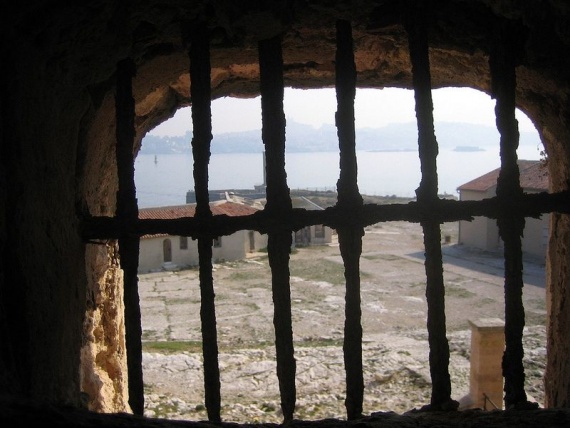
In our time, one of the sites built the cafe, which is designed for tourists interested in such a gloomy place as a truly gothic Chateau d'If. It's interesting that the novel Dumas extended the life of this place. In 1890, when it became known that the castle can be a great place of pilgrimage for tourists who love this novel, it was opened to the public.

The passage between the chambers.

One of the death row.


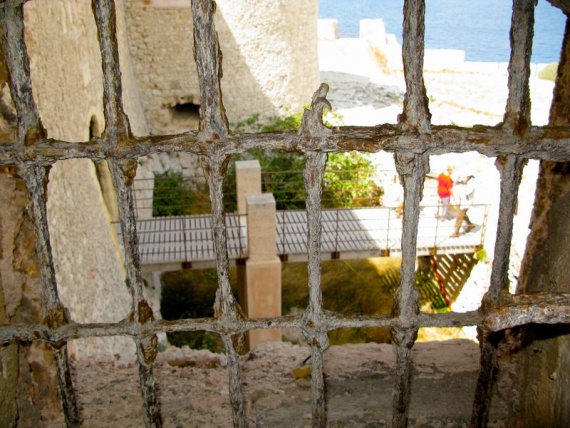
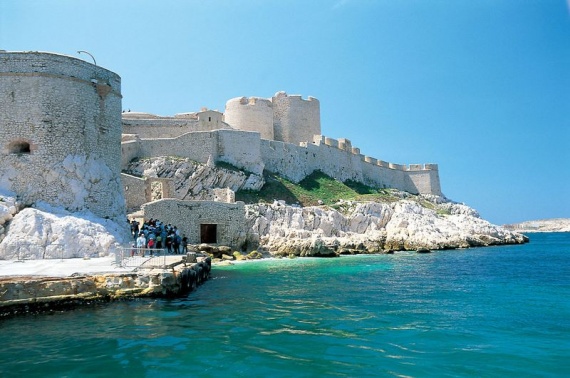
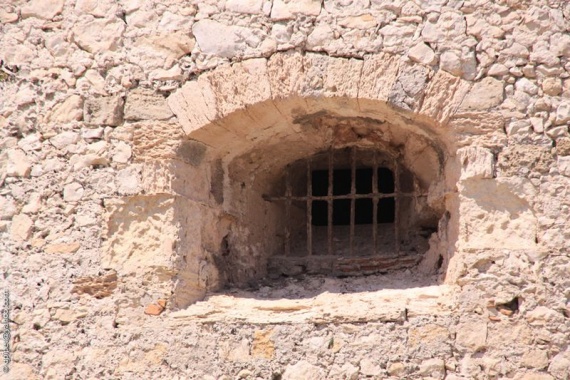
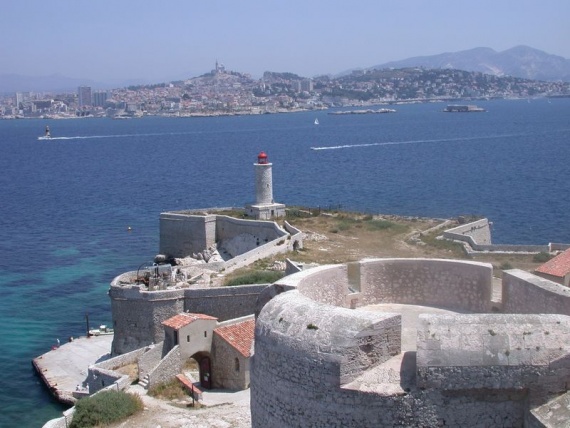
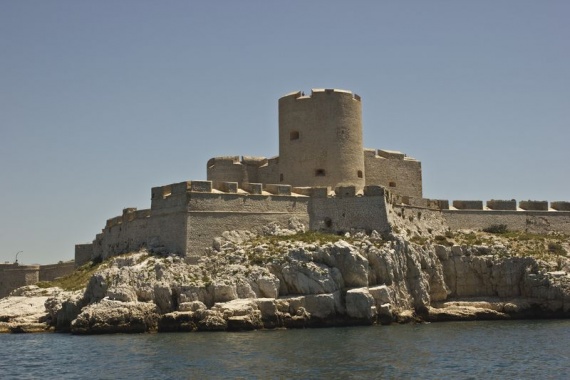

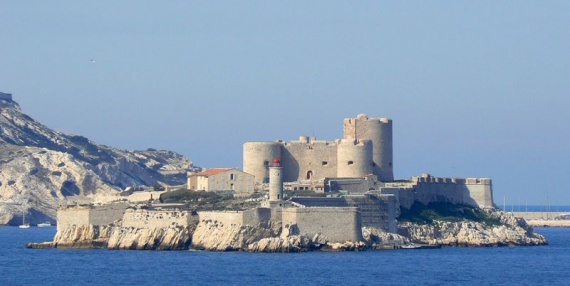
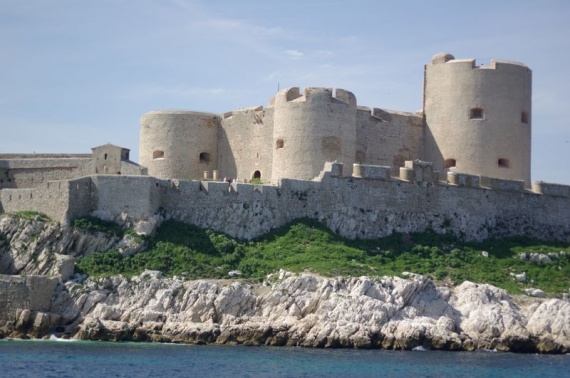
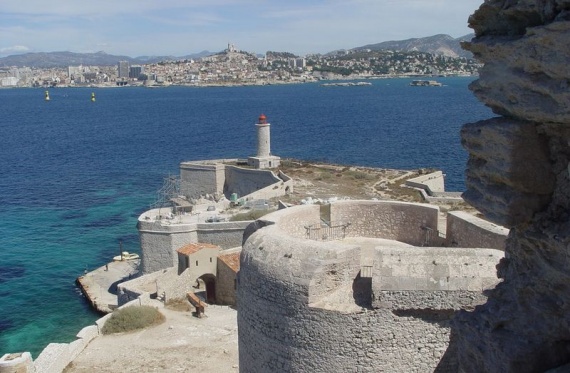

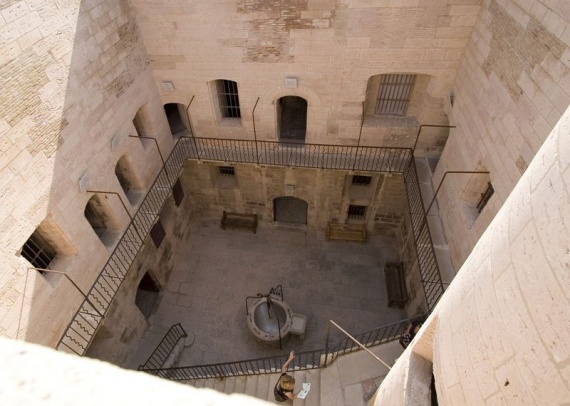
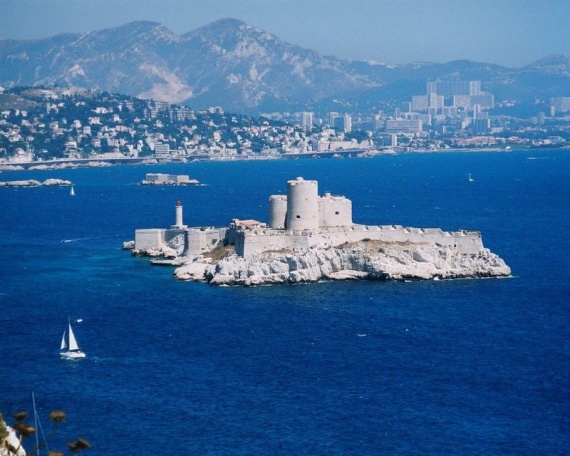

Source: crusoe.livejournal.com, www.intergid.ru , www.allcastles.ru , masterok.livejournal.com Random page
I saw about a hundred yards in front of him a black sheer cliff,
on which stood a dark castle d'If.
This quaint look of this prison, which causes a unprecedent-
worthwhile horror, this fortress, which has three hundred years its powers Marseille
creepy tales, suddenly emerged in front of Dantes, and did not think
about her made him the same effect, which produces a scaffold on
sentenced to death. »
Alexandre Dumas' The Count of Monte Cristo »

We all grew up on the books of Alexandre Dumas. One of his most successful and memorable works was the novel about a prisoner of the Chateau d'If "The Count of Monte Cristo." This famous novel was written during the years 1844-1845. To work turned plausible, the author personally bed all those places in which his characters were traveling.
So, France Corsica, Paris, Marseille, and finally, the Chateau d'If. That is why the book is so believable. In the former Soviet Union also withdrew their adaptation adventure Count of Monte Cristo, which still has not lost its relevance. Dark castle, in which the protagonist languished for many years, actually exists. Inspired by a real Chateau d'If, Alexandre Dumas created a terrible, tragic story about an incredibly strong man imagines himself equal to God and considers himself a hand of Providence. It is often the case that, if the characters are written out by this master, they seem quite real fans.
No wonder England on Baker Street, there is a house-museum of Sherlock Holmes, who never existed, but whose address still get letters addressed to the brilliant detective. So many fans Count of Monte Cristo at the eyes to see the Chateau d'If and the camera, which allegedly languished Edmond Dantes. Therefore, the lock, even architecturally inferior to many castles of France, thanks to the immortal genius of Alexandre Dumas, became a symbol of the will to live Edmond Dantes, once vowed to avenge his enemies.

Chateau d'If (fr. Shâteau d`If) located in the south of France in the department of Bush du Rhône (Bouches-du-Rhone) on the smallest island in the archipelago of Friuli (L`Archipel du Frioul), that are located within a mile of the coast of Marseille . Chateau d'If was built in 1527-1531 gg. on the orders of François I to protect the city against attacks from the sea. The castle has never been attacked and survived to our time in perfect condition. Today, Chateau d'If - one of the "business card" of Marseille. Many visitors tend to visit the castle. Castle guided tours on the camera, sold souvenirs, and in the open air is a cafe with a view of Marseille.

From what began the history of the island, which was later built the castle of If? Caesar mentioned the island, when he found himself near Marseille and settled on this small island for a few days before the battle.
Ifs Island archipelago of Friuli, adjacent to the islands and Pomeg Raton, is surprisingly close to Marseille, and is well seen, especially with the Corniche. Small, neat and high. At its widest point the island reaches 180 m., And its maximum length - 300 m. For a long time the island served as a refuge for pirates, smugglers, fishermen and hunters. Actually exists to the present day Chateau d'If was built in 1527-1531 gg. to protect the coast of Marseilles from enemy attack from the sea. Funny, that never in the Chateau d'If was not committed any attacks that made him to have survived in excellent condition and is a great temptation for tourists as fans of Dumas, who want the hard way to try to imagine the pain and suffering invented Edmond Dantes and those who simply love the well-preserved castles. The French title of the Chateau d'If Shâteau d`If. It is located in the Mediterranean Sea on the southern side of France in one of the small islands of the archipelago Friuli (L`Archipel du Frioul), in the department of Bush-du-Rhone. This protective structure protecting the sea lanes leading to Marseilles, its area is 30 thousand square meters.

The castle itself is located within a mile of the coast of Marseille. The castle seems grown into the rock, as it was built and it is in the rock, towering over the island is only the external structure of the square shape with three round towers and a small patio. The outer walls merge with rocks. Also in the castle is a lighthouse. Ramparts of the castle towering over the island, they can be seen far from the sea and the coast. At the end of the XVI century on the perimeter of the island was built a fortress wall, observation tower and the church. In Marseille, Chateau d'If is very popular, there just bursting with tourists, the castle - former defensive bastion never empty. In spite of its defensive function, according to the engineer Vauban, Chateau d'If was built very badly, in a hurry, with a lot of flaws and punctures. So maybe the Chateau d'If lucky, he has never he did not have a direct role to carry out their protection from attack. Though, perhaps, many of the enemies of France, Marseille is not attacked because of the fearsome If Castle, who knows?
Only in the 1531 Spanish King Charles V decided to attack Marseilles, but for some reason changed his mind. The French believe that the king was frightened Chateau d'If. Perhaps the way it really was. What about the second role of the Chateau d'If, as so poetically described by Dumas and gloomy, the Chateau d'If indeed served as a prison for the politically unreliable Huguenots and other exiles who were not satisfied with the then political leadership of France.

Around 3500 and more prisoners were imprisoned in the Chateau d'If, why the protective structure has not got the best, rather grim reputation. The Chateau d'If in addition to personalities representing political danger for the French policy at the time, were also imprisoned leaders of the Paris Commune. Many Protestants, who were in the Chateau d'If from 1689, and there ended his life. From celebrities to the Chateau d'If languished young Mirabeau, who spent six months in prison, planted with his own father. But his camera was a luxury he could even hold in their methods. Despite the legend got accustomed, even one of the characters of Dumas - the mysterious Iron Mask - was imprisoned in the castle, as the Marquis de Sade, who was in many places, but not on this island.
But the camera sinister If Castle dissolute remember the hermit, which eventually burned at the stake, the captain of the ship "Grand St. Anthony", who was responsible for spreading the plague to Marseille and many other accidents have become captives of the stone walls of the world famous prison. In 1830 in the Chateau d'If criminals have stopped planting, but in 1871, here exiled leaders of the Paris Commune, and Gaston Cremieux, their leader, was shot in the territory of the Chateau d'If. The only time the gun fired on the island of Chateau d'If it happened when King Francis I met Catherine de Medici.

The military garrison on the island was served by a man of sixty.
The very first inmates of the castle was a knight Anselm, who was killed in his cell. Then, there is contained a lot of convicts, and even a sailor who rudely told his captain sat in his cell for 30 years.

In what conditions contained prisoners? The rich, who could and from prison to manage their condition, settled in the upper chamber, where there was a window and "view of the sea." And the poorest thrown into the interior of the castle close to the camera without a single window.
For tourists, the castle was opened in 1890, and the demilitarized at the end of the 19th century. July 7, 1926 Chateau d'If a special decree was entered in the list of historic monuments of great national importance for France. To swim to the Chateau d'If is required to overcome the old pier and ancient fortifications made of stone. Steep road to the ancient walls leading to the castle itself, which is also a former Marseille plague quarantine. To climb to the castle, to climb the spiral staircase and exit the stuffy narrow courtyard, where there is a well, terrace with casemates, separated from each other by a rusty lattice. Each dungeon is marked commemorative plaque.

Narrow window detention cells If Castle casemate above each affixed memorial plaque: "Lock-man, nicknamed" the Iron Mask, "" The Comte de Mirabeau had spent the years 1774-1775 ", and finally" punishment cell E. Dantes, the Count of Monte Cristo. "


And it is "the same hole" through which Edmond Dantes climbed to the Abbe Faria.

For those who are really keen on creativity Dumas and his mysterious character Count of Monte Cristo, of course, is not difficult to guess that a real camera, which languished Edmond Dantes in the Chateau d'If, of course not. Although, as tourists in England show house of Sherlock Holmes, and tourists craving to admire the camera Edmond, show one of the cameras. Of course, this is not the dark chamber in the cave, which was mentioned in the novel, and the usual camera for state criminals.

In these cells kept as described by Alexander Dumas, is the state of criminals in the 19th century, when the Chateau d'If served as a prison. Until the 19th century, is erected in 1524 on the orders of François I, the castle was a protective garrison and as a place of incarceration of criminals unused. Now, this popular tourist castle receives many visitors from all over the world, then sell souvenirs, show the cell where prisoners were held as well as on the grounds of the castle there is a great cafe with a view of Marseille.

No less striking character of the famous works of Alexandre Dumas' The Count of Monte Cristo "is the Abbe Faria, who was the famous writer" settled "in the next cell Edmond Dantes in the Chateau d'If. It is this true scientist Edmond became a mentor in the Chateau d'If, and helped him to come to the image of a perfect being. There Is Abbe Faria really? Or it is the same way the fruit of the author of fiction, as does the Count of Monte - Cristo?

Dungeon Comte de Mirabeau, one of the most famous orators of the French Revolution.
Yes, Abbe Faria - a real historical person. In fact, the Abbe Faria owned hypnosis techniques, which he learned in India, where he was born. As in the novel, the Abbe Faria had dreamed about the independence of his people, he was able to speak beautifully and drag the human mass. And in real life Faria was in the role of perpetrator for their bold ideas about the freedom of his people. As a very dangerous criminal, shackled in chains, he was sent to Lisbon, and three years later the unknown patron helped courageous scientist flee to France. His book about hypnosis and hypnotic sessions in France were a great success, but for conspiring against the government of the abbot again crammed in solitary confinement in the Bastille. Again, a daring escape that failed bookish character of Dumas. And the Abbe Faria involved in the storming of the Bastille. And yet, like the book character Dumas, the real Abbe Faria died in prison in 1819, but not in the Chateau d'If.

Camera Abbe Faria.

The heroes of Alexandre Dumas will live in our memories and our hearts, no matter what they never existed. It is quite banal protective structure made carelessly and in haste, Chateau d'If on the tiny island, will attract a new generation of tourists who, walking along Marcel will look hut bride Edmond, Mercedes, and the sea will represent the final journey seaman Dantes boat with escort when he opened the terrible and frightening sight - Chateau d'If on the horizon, its many years of prison, where he was in his last years was able to learn the secret of the treasure on the island of Monte Cristo, learn several languages, learn the truth about their enemies and become a philosopher. And all this thanks to the Chateau d'If and Abbe Faria.

And it may be so for many tourists Chateau d'If is not a symbol of the terrible prison, where groans unfortunate prisoners, who gave the castle all his life, as a symbol of refuge for one of the most charismatic and brilliant fictional men of the last century. Chateau d'If inspired Alexandre Dumas in the image of the ideal avenger, an angel with black wings, the perfect instrument of Providence.

The castle was built directly into the rock. on the surface of the island is located just a square building with a courtyard and three round towers. The castle is also a lighthouse and walls blend the edges of the rocks. High bastions crowned island cliffs, looking towards the sea and the coast.

In our time, one of the sites built the cafe, which is designed for tourists interested in such a gloomy place as a truly gothic Chateau d'If. It's interesting that the novel Dumas extended the life of this place. In 1890, when it became known that the castle can be a great place of pilgrimage for tourists who love this novel, it was opened to the public.

The passage between the chambers.

One of the death row.















Source: crusoe.livejournal.com, www.intergid.ru , www.allcastles.ru , masterok.livejournal.com Random page
